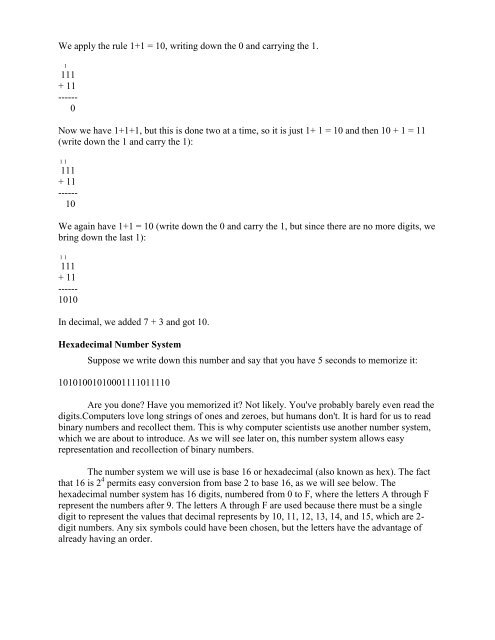Number Systems Humans use the decimal number system to ...
Number Systems Humans use the decimal number system to ... Number Systems Humans use the decimal number system to ...
We apply the rule 1+1 = 10, writing down the 0 and carrying the 1. 1 111 + 11 ------ 0 Now we have 1+1+1, but this is done two at a time, so it is just 1+ 1 = 10 and then 10 + 1 = 11 (write down the 1 and carry the 1): 1 1 111 + 11 ------ 10 We again have 1+1 = 10 (write down the 0 and carry the 1, but since there are no more digits, we bring down the last 1): 1 1 111 + 11 ------ 1010 In decimal, we added 7 + 3 and got 10. Hexadecimal Number System Suppose we write down this number and say that you have 5 seconds to memorize it: 10101001010001111011110 Are you done? Have you memorized it? Not likely. You've probably barely even read the digits.Computers love long strings of ones and zeroes, but humans don't. It is hard for us to read binary numbers and recollect them. This is why computer scientists use another number system, which we are about to introduce. As we will see later on, this number system allows easy representation and recollection of binary numbers. The number system we will use is base 16 or hexadecimal (also known as hex). The fact that 16 is 2 4 permits easy conversion from base 2 to base 16, as we will see below. The hexadecimal number system has 16 digits, numbered from 0 to F, where the letters A through F represent the numbers after 9. The letters A through F are used because there must be a single digit to represent the values that decimal represents by 10, 11, 12, 13, 14, and 15, which are 2- digit numbers. Any six symbols could have been chosen, but the letters have the advantage of already having an order.
Decimal Hexadecimal 0 0 1 1 2 2 3 3 4 4 5 5 6 6 7 7 8 8 9 9 10 A 11 B 12 C 13 D 14 E 15 F 16 10 Reading Numbers in Hexadecimal Just as with binary, it is a common mistake to read hexadecimal numbers with the names from decimal. Hex 30 is not "thirty"; it is read as three-zero. Similarly, hex 15 is not "fifteen," but one-five. Positions in the Hexadecimal Number System The positions in the binary number system are powers of 16, rather than powers of 10 (as in decimal) or powers of 2 (as in binary). 16 3 16 2 16 1 16 0 This means that we can label the columns as follows: 4096's 256's 16's 1's column column column column We will use these positions to evaluate hexadecimal numbers for conversion to decimal. Hexadecimal to Decimal Conversion Here is an algorithm for converting from hexadecimal to decimal: 1. write out the hexadecimal number 2. above the digits, write the powers of 16, starting with 1 at the right and increasing as you move to the left 3. multiply each digit by the power of 16 above it 4. sum the results. (Note that each digit A through F should be converted to decimal before multiplication.) Here's an example. Let's convert A5 from hexadecimal to decimal. First we write out the
- Page 1 and 2: Base Systems Jacqueline A. Jones Pe
- Page 3 and 4: Reading Numbers in Binary Students
- Page 5 and 6: 9 32 16 8 4 2 1 - 8 1 0 1 0 0 -----
- Page 7: Binary Arithmetic Binary arithmetic
- Page 11 and 12: That's no problem, but what about 9
- Page 13 and 14: hexadecimal, as shorthand for long
- Page 15 and 16: ------- 1111 The answer is 1111, or
We apply <strong>the</strong> rule 1+1 = 10, writing down <strong>the</strong> 0 and carrying <strong>the</strong> 1.<br />
1<br />
111<br />
+ 11<br />
------<br />
0<br />
Now we have 1+1+1, but this is done two at a time, so it is just 1+ 1 = 10 and <strong>the</strong>n 10 + 1 = 11<br />
(write down <strong>the</strong> 1 and carry <strong>the</strong> 1):<br />
1 1<br />
111<br />
+ 11<br />
------<br />
10<br />
We again have 1+1 = 10 (write down <strong>the</strong> 0 and carry <strong>the</strong> 1, but since <strong>the</strong>re are no more digits, we<br />
bring down <strong>the</strong> last 1):<br />
1 1<br />
111<br />
+ 11<br />
------<br />
1010<br />
In <strong>decimal</strong>, we added 7 + 3 and got 10.<br />
Hexa<strong>decimal</strong> <strong>Number</strong> System<br />
Suppose we write down this <strong>number</strong> and say that you have 5 seconds <strong>to</strong> memorize it:<br />
10101001010001111011110<br />
Are you done? Have you memorized it? Not likely. You've probably barely even read <strong>the</strong><br />
digits.Computers love long strings of ones and zeroes, but humans don't. It is hard for us <strong>to</strong> read<br />
binary <strong>number</strong>s and recollect <strong>the</strong>m. This is why computer scientists <strong>use</strong> ano<strong>the</strong>r <strong>number</strong> <strong>system</strong>,<br />
which we are about <strong>to</strong> introduce. As we will see later on, this <strong>number</strong> <strong>system</strong> allows easy<br />
representation and recollection of binary <strong>number</strong>s.<br />
The <strong>number</strong> <strong>system</strong> we will <strong>use</strong> is base 16 or hexa<strong>decimal</strong> (also known as hex). The fact<br />
that 16 is 2 4 permits easy conversion from base 2 <strong>to</strong> base 16, as we will see below. The<br />
hexa<strong>decimal</strong> <strong>number</strong> <strong>system</strong> has 16 digits, <strong>number</strong>ed from 0 <strong>to</strong> F, where <strong>the</strong> letters A through F<br />
represent <strong>the</strong> <strong>number</strong>s after 9. The letters A through F are <strong>use</strong>d beca<strong>use</strong> <strong>the</strong>re must be a single<br />
digit <strong>to</strong> represent <strong>the</strong> values that <strong>decimal</strong> represents by 10, 11, 12, 13, 14, and 15, which are 2-<br />
digit <strong>number</strong>s. Any six symbols could have been chosen, but <strong>the</strong> letters have <strong>the</strong> advantage of<br />
already having an order.



